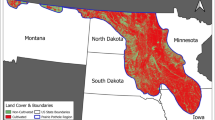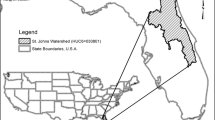Abstract
By 2030, 75,000 ha of raised bog owned by Ireland’s largest peat producer, Bord na Móna, are expected to be exhausted. In an effort to rehabilitate Irish cutaway peatlands to maximise their conservation value, large areas have been converted to wetlands using three alternative approaches: total peat removal (TPR), partial peat removal (PPR), and simple rewetting (SR). This paper assesses the success, to date, of the three wetland creation approaches using hydrochemistry as a measure of restoration success and identifies the key variables influencing hydrochemistry in the created wetlands. Chemical analysis suggests major differences between the TPR and SR wetlands while the PPR wetlands exhibited intermediate characteristics. Additionally, principal component analysis highlighted nitrite, conductivity, turbidity, chlorophyll-a, colour, and soluble reactive phosphorus as important hydrochemical factors determining differences among the three wetland creation approaches. This research shows that wetlands underlain by peaty substrates (PPR and SR) may take longer than 10 years to stabilise hydrochemically compared to those wetlands underlain by solely alkaline sediments (TPR) which stabilise quickly. Although wetland ecosystem development may be slower in the PPR and SR wetlands they hold the greatest potential to develop peat forming habitats. Wetland creation represents a viable and valuable post-harvesting land-uses option for cutaway peatlands.

Similar content being viewed by others
References
APHA (1998) Standard methods for the examination of water and wastewater. American Public Health Association, American Water Work Association, Water Environment Federation, Washington, DC
Blindow I, Andersson G, Hargeby A, Johansson S (1993) Long-term pattern of alternative stable states in two shallow eutrophic lakes. Freshwater Biology 30:159–167
Buckland P, Eversham B, Warburton S (2000) Peatlands, invertebrates and paleoecology: a case study from the Humberhead Levels, U.K. In: Rochefort L, Daigle J (eds) Sustaining our Peatlands. Canadian Society of Peat and Peatlands, and International Peat Society, Edmonton, Alberta, Canada
Caffrey J (1998) A new fishing resource for the Midlands. In: Egan T (ed) The future use of cutaway bogs, proceedings from the first comprehensive conference on cutaway bogland rehabilitation. Brosna Press Ltd, Ferbane, Co. Offaly, Ireland
Desmond M, O’Brien P, McGovern F (2008) Climate Change Research Programme (CCRP) 2007–2013 Report series no. 1 A summary of the state of knowledge on climate change impacts on Ireland. Environmental Protection Agency, PO Box 3000, Johnstown Castle, Co. Wexford, Ireland
Farrell C (2008) The biodiversity value and future management of degraded peatland habitats in Ireland. In: Farrell C, Feehan J (eds) After wise use—the future of peatlands. International Peat Society, Jyvaskyla
Higgins T, Colleran E (2006) Trophic status of experimental cutaway peatland lakes in Ireland and implications for future lake creation. Journal of Environmental Science and Health 41(A):849–863
Higgins T, Colleran E, Raine R (2006) Transition from P- to N-limited phytoplankton growth in an artificial lake on flooded cutaway peatland in Ireland. Applied Vegetation Science 9:223–230
James W, Best E, Barko J (2004) Sediment resuspension and light attenuation in Peoria Lake: can macrophytes improve water quality in a shallow system? Hydrobiologia 515:193–201
Jordan S, Lundin L, Strömgren M, Lode E, Nilsson T (2009) Peatland restoration in Sweden. From peat cutting areas to shallow lakes—after-use of industrial peat sites. In: Silpoda J (ed) Peatlands International 1/2009, International Peat Society, Vapaudenkata 12, FIN-40100 Jyväskylä, Finland
Kieckbusch J, Schrautzer J (2007) Nitrogen and phosphorus dynamics of a re-wetted shallow-flooded peatland. Science of the Total Environment 380:3–12
Lally HT (2010) Wetlands created on Irish cutaway peatlands using three construction approaches with specific references to water chemistry, phytoplankton communities, and habitat recolonisation. Dissertation, National University of Ireland Galway, Ireland
Landers D (1982) Effects of naturally senescing aquatic macrophytes on nutrient chemistry and chlorophyll-a of surrounding waters. Limnology and Oceanography 27(3):428–439
Lorenzen C (1967) Determination of chlorophyll and pheo-pigments: spectrophotometric equations. Limnology and Oceanography 12(2):343–346
Lundin L, Lode E, Strömgren M, Nilsson T (2008) Wetlands: wise after-use at terminated peat cuttings. In: Farrell C, Feehan F (eds) After wise use—the future of peatlands. International Peat Society, Jyvaskyla
McCune B, Grace J (2002) Analysis of ecological communities. MjM Software Design, Gleneden Beach
McNally G (2008) 50 years of research endeavour on the future use of Irish industrial cutaways. In: Farrell C, Feehan F (eds) After wise use—the future of peatlands. International Peat Society, Jyvaskyla
Mitsch W, Wilson R (1996) Improving the success of wetland creation and restoration with know-how, time and self-design. Ecological Applications 6:77–83
Sallantaus T (2004) Hydrochemical impacts set constraints on mire restoration. In: Paivanen J (ed) Wise use of peatlands. International Peat Society, Jyvaskyla
Stephen B, Moss B, Phillips G (1997) Do rooted macrophytes increase sediment phosphorus release? Hydrobiologia 342(343):27–34
Vollenweider R, Kerekes J (1982) Eutrophication of waters: monitoring, assessment and control. Organisation for Economic Co-Operation and Development, Paris
Wheeler B, Shaw S (1995) Restoration of damaged peatlands with particular reference to lowland raised bogs affected by peat extraction. HMSO, London
Wheeler R (1995) Restoration and wetlands. In: Wheeler B, Shaw S, Fojt W, Robertson A (eds) Restoration of temperate wetlands. Wiley and Sons, Chichester
Acknowledgments
We thank Owen Doherty and Tom Lally for assistance with all aspects of field work, Gerry McNally, Catherine Farrell, and Tom Egan for all their support and advice, Christopher Williams for all his help and advice with PC-ORD, and Line Rochefort for comments made on this manuscript. We thank the Environmental Change Institute, NUI Galway for providing research facilities. This work was funded by Bord na Móna, the generous financial support of which is gratefully acknowledged.
Author information
Authors and Affiliations
Corresponding author
Electronic supplementary material
Below is the link to the electronic supplementary material.
ESM 1
(PDF 79.5 kb)
Rights and permissions
About this article
Cite this article
Lally, H., Gormally, M., Higgins, T. et al. Evaluating Different Wetland Creation Approaches for Irish Cutaway Peatlands Using Water Chemical Analysis. Wetlands 32, 129–136 (2012). https://doi.org/10.1007/s13157-011-0257-5
Received:
Accepted:
Published:
Issue Date:
DOI: https://doi.org/10.1007/s13157-011-0257-5




